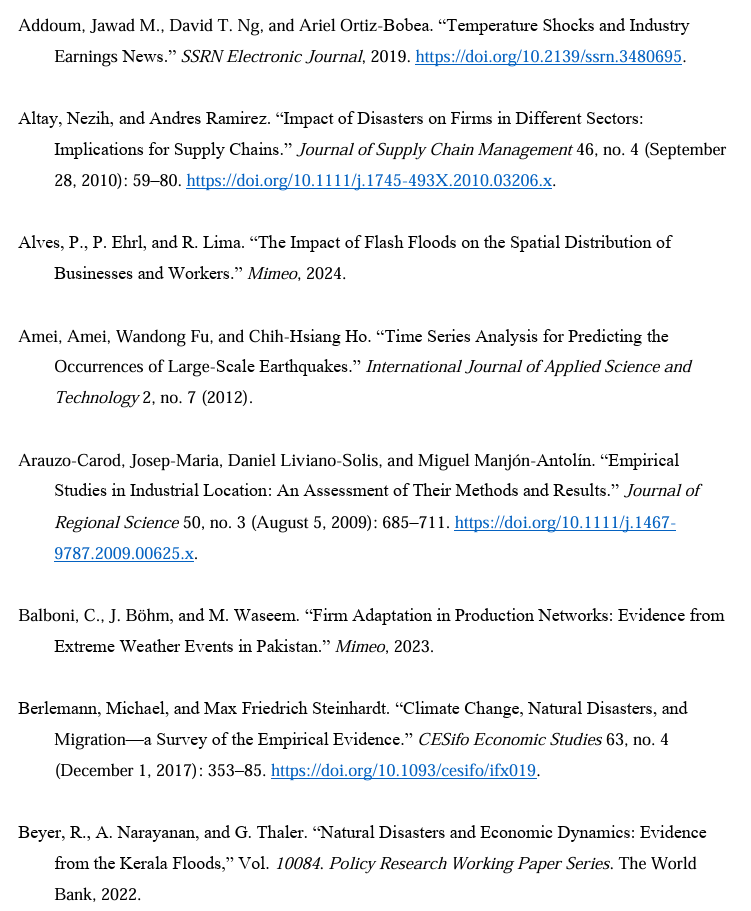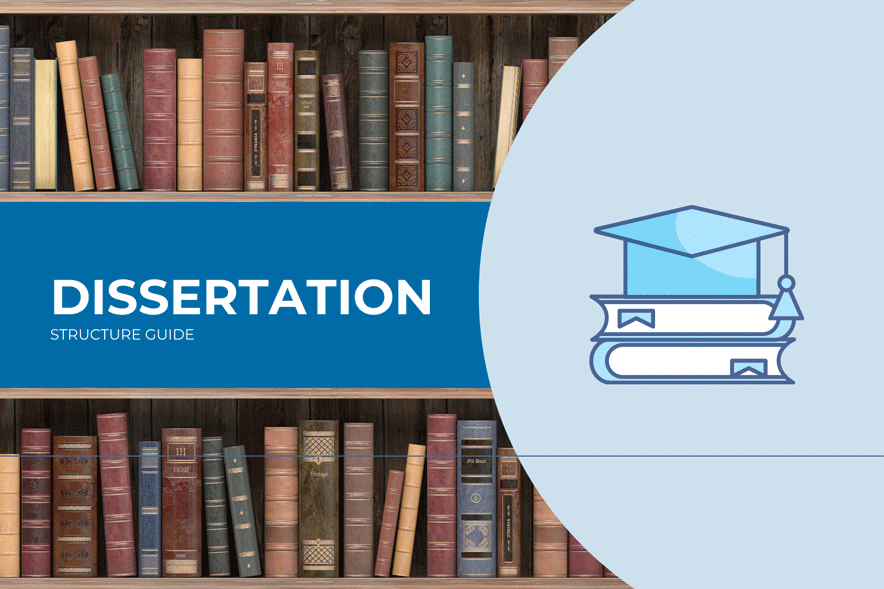In this guide we explain how to structure a typical dissertation, and we look at how this can change for different subjects. While your university may require other sections, the following diagram shows the core elements together with a typical length for each of the sections.

Differences in dissertation structure by subject:
Dissertation structures can vary, depending on the subject you are studying for.
- STEM subjects, including Science, Tech, Engineering + Maths: These usually follow the IMRaD format (Introduction, Methods, Results, and Discussion). The methodology and results sections may be more detailed than for other areas of study, often with extensive data analysis.
- Humanities: These subjects may be organised like an extended essay, with the chapters based on themes or arguments.
- Social sciences: These can be similar to STEM subjects, but there is a lot of emphasis on theoretical frameworks and qualitative analysis. They may also have additional sections for theoretical discussion and empirical findings.
- Law: The structure for these can vary depending on the level and course (e.g. Undergraduate, Masters, Post Graduate Diploma). They may be more like an extended essay, focusing on legal arguments, analysis of precedents and critical evaluation of legal texts.
- Business + Management: These usually combine both theoretical and practical components. They might have sections explaining the industry context, data-driven analysis, and recommendations for application.
The above is just a general guide. You should check whether your university has issued any specific guidance for your area of study.
Title page
The title page should contain key details about your dissertation. Most universities have strict formatting requirements which you should check carefully. They may be unique to your university, or sometimes based on academic writing styles e.g. APA style, Chicago. Requirements may include font size, line spacing, margin size, paragraph alignment/indentation, capitalisation and sometimes even the University logo. Usually, you’ll centre your content and won’t use a page number on the title page.
Typically, a dissertation title page includes:
- Title of the dissertation
- Your full name
- Your student ID
- Department and university name
- Degree program and submission date
- Supervisor’s name
Example of a dissertation title page

Formulating a strong title
Your dissertation title should be clear, concise, and informative. It should set the stage for your research, and should reflect your study’s key focus and limitations. Stick to these guidelines when writing your title:
- Be specific: Avoid vague titles.
- Carefully outline the research scope: Make sure it is clear exactly what you will (and therefore will not) cover.
- Use keywords: Ensure your title includes relevant terms so your work is easier for people to find.
- Maintain clarity and readability: Avoid jargon, abbreviations or being too wordy.
- Include key elements of your research strategy where relevant: e.g. contextual focus, target population, chosen methodology.
One way to formulate an effective title is to write it in two parts. Divide the parts with a semi-colon: a general area, followed by the more specific focus. For example:
- Prenatal stress: relevance to major depressive disorder
- Dementia: how changing perspectives affect clinical decision making
Abstract
The abstract part of your dissertation structure is a concise summary of your entire dissertation, typically between 150-300 words. It provides an overview of your research, including:
- Research aim and objectives
- Methodology used
- Key findings
- Conclusions and implications
Abstract structure example:
- Background: Briefly introduce the topic and research problem.
- Aim & objectives: Clearly state what the research seeks to achieve.
- Methodology: Summarise the methods used (e.g., qualitative, quantitative, mixed methods).
- Key findings: Highlight the most important results.
- Conclusion: Summarise the implications of your findings.
Example abstract:
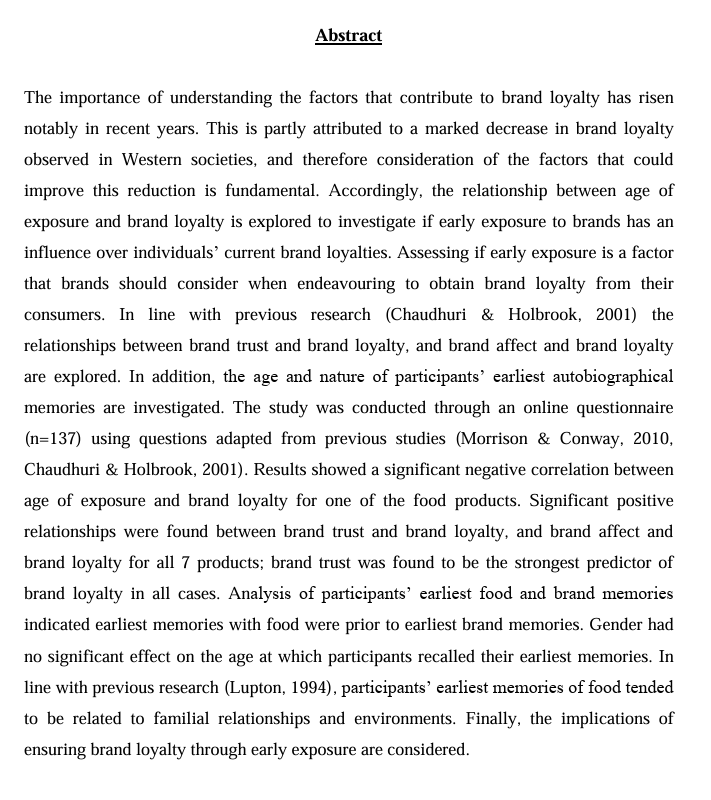
Table of contents and lists of figures/tables
Automatically generating a table of contents
Using built-in heading styles in Word or Google Docs allows you to generate a Table of Contents (ToC) automatically.
In Microsoft Word:
- Apply ‘Heading 1’, ‘Heading 2’, etc. to your section titles.
- Go to the location where you want the ToC.
- Click References > Table of Contents and select a built-in style.
In Google Docs:
- Use ‘Heading 1’, ‘Heading 2’, etc. for section headings.
- Place your cursor where you want the ToC.
- Click Insert > Table of contents, then choose a plain text or linked style.
Formatting & numbering sections
Proper section numbering improves navigation and readability. For example:
1. Introduction
2. Literature Review
2.1 Key Themes
2.2 Theoretical Framework
3. Methodology
Use consistent formatting throughout – this helps when auto-generating a ToC and gives your document a professional appearance.
When to include lists of figures, tables, and abbreviations

Include these lists if you use multiple figures, tables, or specialist terms in your dissertation:
- List of figures: Add this if your dissertation includes several graphs, charts, or images. Each figure should have a number, title, and page number.
- List of tables: Required when your dissertation uses multiple tables. Use the ‘Insert Caption’ tool in Word to manage numbering.
- List of abbreviations: Include this if you use specialist abbreviations or acronyms that may not be familiar to all readers. List them alphabetically with definitions.
These lists should appear directly after the Table of Contents.
Acknowledgements (optional)
What to include in acknowledgements
The acknowledgements section of your dissertation structure gives you an opportunity to thank the people and institutions who supported you during your dissertation. It should be placed after the abstract and before the table of contents.
You might want to acknowledge:
- Academic support – such as your supervisor, tutors, or any academic staff who guided you.
- Funding bodies or institutions – if you received a scholarship or research funding.
- Participants or organisations – involved in your research.
- Personal support – including family, friends, or anyone who provided emotional or practical help.
Keep this section professional, sincere, and concise. You can use a more formal tone for academic acknowledgements and a slightly informal tone for personal thanks.
Examples of acknowledgements
Formal example:
I would like to express my sincere gratitude to Dr. Emily Thompson for her invaluable supervision, feedback, and encouragement throughout this research. I also wish to thank the Department of Health Sciences for providing access to necessary resources.
Informal Example (for personal support):
I’m incredibly grateful to my family for their endless patience and support, and to my friends for keeping me grounded (and caffeinated) during this process.
You don’t have to include an acknowledgements section. However, it’s a thoughtful addition that allows you to show appreciation for the help you received.
Introduction
The introduction section of your dissertation structure is typically around 8% of your word count. It sets the stage for your entire dissertation.
Your introduction outlines what your research is about, why it’s important, and what the reader can expect from the rest of the document. A strong introduction grabs attention, provides essential context, and guides the reader through your research journey.
How to write a strong opening statement
Start with a sentence that engages the reader. This might be a striking statistic, a quote, a relevant issue, or a compelling research gap. Your goal is to quickly establish the relevance and significance of your topic.
Example opening lines:
With dementia diagnoses rising globally, clinicians face increasing complexity in treatment planning.
In recent years, shifting societal attitudes toward cognitive decline have significantly influenced healthcare strategies.
Key elements to include
- Background and context – Outline the broader topic and why it matters.
- Research problem or gap – Clearly identify the issue your study addresses.
- Aim and objectives – What do you hope to achieve?
- Research questions – What specific questions will your study answer?
- Overview of the structure – Briefly explain how your dissertation is organised.
Example introduction:
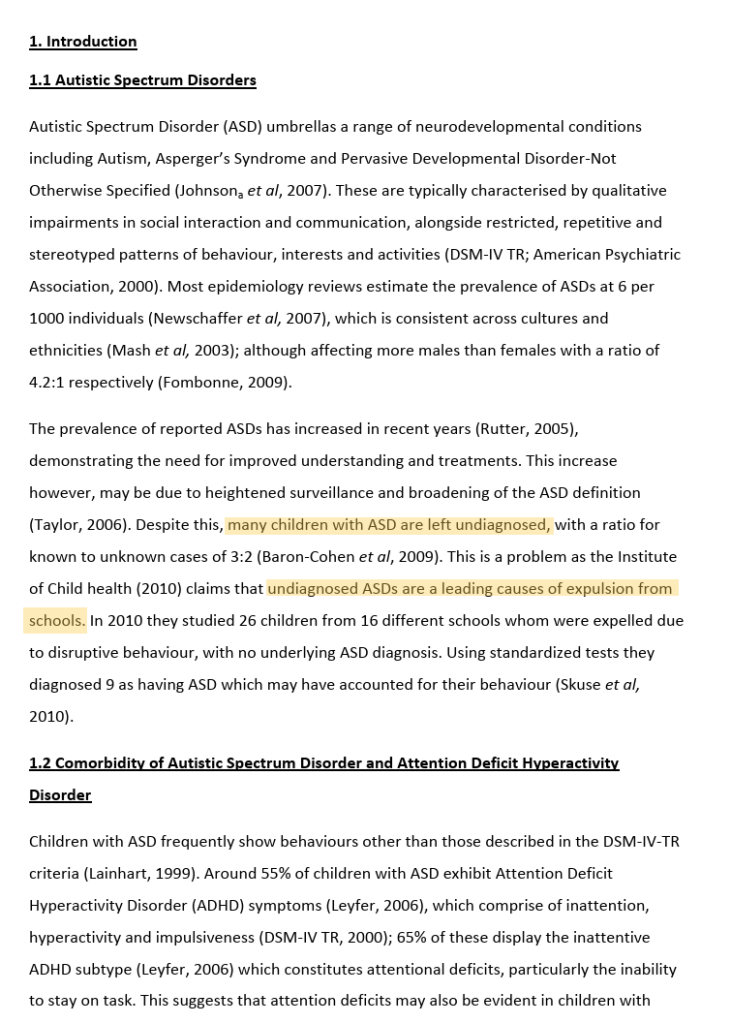
Literature review
The literature review section of your dissertation structure is a comprehensive survey of scholarly sources (such as journal articles, books and reports) on a specific topic. It is typically around 30% of your word count. The aim of your literature review is to:
- Establish the academic context of your research by showing familiarity with existing work in the field.
- Summarise and synthesise previous studies, highlighting major themes, findings, and debates.
- Identify gaps or inconsistencies in the literature – areas where further investigation is needed – which your dissertation aims to fill.
By the end of the literature review, the reader should clearly understand how your research connects to and builds upon existing knowledge, and why your research questions are worth addressing.
Unlike an annotated bibliography, you are not just describing what each source says. Instead, you are weaving sources together to tell the story of your topic and to support the rationale for your own research. This means the literature review must be critical: you will:
(a) evaluate the strengths and weaknesses of existing research,
(b) compare different viewpoints or findings; and
(c) show how they relate to each other.
The goal is to provide a well-rounded, analytical discussion of the field that demonstrates insight – not just a catalogue of who said what.
Finding and organising sources
Conducting an effective literature review starts with finding the right sources and keeping them organised. A systematic search strategy will save you time and ensure you cover the most relevant literature:
- Search widely and strategically: Begin by searching academic databases, library catalogues, and scholarly search engines (e.g. Google Scholar) for your topic. Use specific keywords and Boolean operators to narrow down results. Consider synonyms or related terms to broaden the search if needed. Aim to collect a comprehensive set of sources that relate directly to your research questions. Keep an eye out for literature reviews or meta-analyses published on your topic – these can be goldmines for references and give you an overview of the field.
- Focus on quality and relevance: Prioritise peer-reviewed journal articles, reputable books, and official reports over less reliable sources. A strong literature review is built on credible academic research. Avoid over-relying on non-academic sources like random websites or opinion pieces. Ensure you include both landmark studies (classic, influential works in your field) and current research from the last few years – this balance shows you understand the foundations of the topic and how it has developed up to the present. Skimming recent journal articles or dissertations in your area can help you identify what has already been well-studied and what questions remain open.
- Evaluate and select sources: As you find literature, evaluate each source’s abstract and conclusions to decide if it truly pertains to your study. It’s easy to be overwhelmed by too many references, so be selective. Keep the focus on research that directly informs your specific topic or problem (quality over quantity). Discard sources that are only tangentially related – an unfocused collection of references will lead to an unfocused review.
- Organise your references and notes: Keeping your sources organised is essential for writing a coherent review. Use a reference management tool (such as Zotero, EndNote or Mendeley) to store bibliographic information and PDFs, and to insert citations easily later. Develop a system to categorise sources (for example, by theme, methodology, or chronology) even before you start writing. Take detailed notes on each source, summarising the key findings, arguments, methods, and any limitations. It helps to also note how each source connects to your research question or to other sources (e.g. does Study A support or contradict Study B?). These notes will make it easier to group studies into themes and will be invaluable when you begin drafting the review.
- Keep track of citations: As you compile sources, record all necessary citation details (author, title, year, publication, etc.) to avoid scrambling for them later. This habit will save you time and prevent errors when finalising your reference list. Properly cataloguing your sources from the start also guards against accidental plagiarism, since you’ll always know which ideas came from which source.
The University of Bath has an excellent resource on conducting a literature search here.
Structuring the literature review
There is no single formula for structuring a literature review, but it should be organised in a logical, reader-friendly way. A common mistake is to discuss studies one after another in an arbitrary sequence; instead, you need to group and order your discussion in a way that highlights the overall trends and arguments in the literature. Your literature review will be structured thematically, chronologically, or methodologically – or a combination of these approaches:
- Thematic structure: This approach organises the literature review by theme or topic. You identify the key themes or issues that recur across the literature and structure your review around those. For example, in a literature review about improving public health outcomes, you might have sections on themes such as policy interventions, socio-economic factors and cultural barriers. Each thematic section would discuss a range of studies relevant to that theme, comparing their findings and showing how they collectively advance understanding of that aspect. A thematic structure is useful for highlighting different facets of a complex issue and for synthesising various sources that address similar questions or problems.
- Chronological structure: This approach traces the development of research over time. You might start with the earliest relevant studies and progress to the most recent. A chronological review can reveal how thinking on your topic has evolved – for instance, how theories have changed or how research focus has shifted over the years. However, be careful: a purely chronological list can become just a historical summary. To avoid simply listing studies in date order, discuss patterns, turning points, and key developments – for example, note when a significant shift in understanding occurred or how later research built on (or refuted) earlier findings. Your narrative should explain the progression of knowledge and why changes occurred, not just when they occurred.
- Methodological structure: If the body of literature involves diverse research methods or disciplinary perspectives, it can be effective to organise your review by methodology. This means grouping studies by the type of research or approach used. For example, you could compare qualitative versus quantitative research results on your topic, or group studies by their disciplinary approach (e.g. psychological studies, computational studies, case studies, etc.). This structure highlights how different approaches to the same question yield different insights, and allows you to discuss the strengths and limitations of each method in addressing your research problem.
These structures are not mutually exclusive – in fact, many literature reviews combine them. For instance, you might have overall thematic sections, within which you arrange studies chronologically to show developments within each theme. The key is to choose an arrangement that best showcases the relationships among the sources you’re reviewing and leads logically to your own research questions. Whichever structure you choose, use clear signposting (subheadings and transition sentences) so the reader can easily follow the flow of ideas.
How to critically analyse sources
A high-quality literature review doesn’t just summarise previous studies – it critiques and synthesises them. Your task is to engage critically with the literature, which means evaluating and commenting on what you read rather than accepting it all at face value. Here are strategies to ensure your literature review is analytical and not merely descriptive:
- Compare and synthesise findings: When discussing a set of sources, don’t present each one in isolation. Instead, draw connections between them. For example, you might point out that two studies had similar findings despite using different methods, or that a later study challenged the conclusions of an earlier one. By grouping and comparing studies in this way, you create a synthesis – a cohesive picture of the state of knowledge on that topic.
- Analyse, don’t just describe: Go beyond paraphrasing what each author did and found. Discuss why the results matter and what they mean in context. If a study reports a particular outcome, comment on its significance for the field: does it support a prevailing theory, or does it challenge it? Look for themes, trends, and discrepancies in the findings of different works. Consider why certain patterns might appear, or why studies disagree. This interpretative step shows that you are thinking critically about the implications of the findings, not just cataloguing them.
- Evaluate strengths and limitations: As you review each source, assess its credibility and contribution. Note aspects like the research design, sample size, and potential biases or limitations. For instance, a qualitative case study might provide deep insight but be limited to a specific context, whereas a large-scale survey offers breadth but might overlook nuances. A critical literature review will mention these kinds of strengths and weaknesses of existing studies. By evaluating the literature, you can demonstrate how much weight can be placed on particular findings, and highlight which evidence is most robust or relevant.
- Use signposting and transitions: To maintain a critical narrative flow, write in well-structured paragraphs and use clear transitional words to connect ideas. For example, you might start a sentence with “However,…” or “Similarly,…” to juxtapose studies, or use phrases like “In contrast to X’s findings, Y found…” to directly compare sources. These linguistic cues help the reader follow your reasoning and see the relationships you’re drawing between sources. Each paragraph should have a clear focus (often a sub-topic or a point of comparison) rather than just summarising one source at a time.
- Keep your research question in sight: While analysing the literature, continually relate your discussion back to your own research problem. Highlight how the literature supports or informs your approach, and where there are gaps that your study will fill. For instance, you might point out that despite many studies on Topic A, no research has yet examined it in the specific context or using the approach that you propose – thereby framing your project as a needed contribution. This ensures your literature review is building a case for your research. The critical analysis isn’t just about critiquing others for the sake of it, but setting up the justification for your own study.
By approaching the literature review with the “critical analysis dial turned up to full volume”, you will show the reader (and your supervisor) that you have a deep, evaluative understanding of the existing work. Remember, the literature review is your opportunity to demonstrate the state of knowledge on your topic and to argue why your perspective or research is necessary given what’s already been done.
Methodology
The methodology chapter of your dissertation structure is typically around 15% of your word count. It explains how you conducted your research and why you chose those methods. It enables readers to evaluate the study’s reliability and replicate your procedures if needed. In practical terms, this section provides a clear roadmap of your research design – without unnecessary detail or digression – so that the reader understands exactly what you did to gather and analyse data. It is written in a factual, concise manner (usually in past tense), focusing on your research process rather than results or theory.
What goes into a Methodology section
A strong methodology section covers every aspect of how the research was carried out, giving enough detail that another researcher could repeat the study. Typically, you should include:
- Research design and approach: State the overall approach (qualitative, quantitative or mixed methods) and the type of study (e.g. experimental, survey-based, observational). Explain why this design is appropriate for your research question.
- Data collection methods: Describe what data you collected and how. For example, did you conduct interviews, distribute questionnaires, run lab experiments, use existing datasets, or observe participants? Provide details of your procedure for each method.
- Context and samples: Clarify where and when the research took place and who or what you studied. For instance, note the number of participants and key characteristics (if human subjects), or the sources of materials/data. This situates your methodology and aids replicability by showing the research setting.
- Data analysis methods: Explain how you processed and analysed the data. Specify any analytical techniques, statistical tests, or qualitative analysis procedures (e.g. thematic analysis for interview transcripts, regression analysis for survey data). Include any software or tools used (such as NVivo for qualitative coding or SPSS for statistics).
- Tools and materials: Mention any special equipment, instruments, or materials needed for your research. Identify the lab apparatus, computer programs, and measurement instruments you used so the reader understands what was required to conduct your study.
- Ethical considerations: If your research involved human participants or sensitive data, outline the ethical steps taken. Describe how you obtained informed consent, guaranteed confidentiality, and minimised any risk or harm to participants. If an ethics committee required formal ethical approval, clearly state that you obtained it.
- Obstacles or limitations: Acknowledge any practical challenges or limitations encountered in conducting the research. For instance, if there were difficulties in recruitment, equipment failures, or constraints like time and budget, briefly note how you mitigated or overcame these issues. Being transparent about such limitations demonstrates rigour and honesty. (You will reflect further on the impact of limitations in your discussion chapter, but mentioning them here shows you planned carefully and were aware of potential weaknesses.)
- Justification of choices: Crucially, explain why you adopted these methods and design. For each significant choice – whether it’s using a survey, a case study, a simulation model, etc. – provide a rationale. The goal is to convince the reader that your approach was the best fit for your research aims and questions. This justification is woven throughout the methodology, rather than a separate section, but it’s highlighted here because it’s so important (and often rewarded by markers).
The video below is a helpful guide to narrowing down the scope of your dissertation.
Keep the methodology section of your dissertation structure focused on methods – do not stray into a literature review of background information or start discussing your results. Make sure every element directly relates to how you are conducting your research.
Qualitative vs. quantitative research methods
Early in your methodology, you will identify whether you took a qualitative or quantitative approach (or a combination). Understanding the difference will guide how you present and justify your methods:
Quantitative methods:
These deal with numbers, measurements and statistics. Use a quantitative approach when your aim is to test hypotheses, measure variables or quantify relationships. It is suited for research that requires structured data and objective analysis – for example, measuring the effect of one variable on another, or gathering broad data from a large sample. Common quantitative methods include experiments, surveys, structured observations, and analysis of numerical datasets. Quantitative research allows you to systematically measure variables and test hypotheses in a formal, generalisable way. Choose a quantitative design if you want to produce statistically reliable results that you can generalise to a larger population.
Qualitative methods:
These deal with words, observations and meanings rather than numbers. Choose a qualitative approach when your goal is to explore ideas, experiences, or social contexts in depth. Qualitative research is ideal for understanding how or why something happens, capturing rich detail and nuance that numbers alone can’t provide. Methods are typically more flexible and open-ended – e.g. interviews (structured, semi-structured or unstructured), focus groups, ethnographic fieldwork, case studies, or content analysis of texts/images. Because qualitative research yields descriptive data (like interview transcripts or field notes), your analysis will involve identifying patterns, themes and interpretations rather than statistics. Qualitative methods allow you to explore concepts and experiences in detail, providing insight into participants’ perspectives, motivations, and behaviours. This approach is valuable when you need depth over breadth, or when the research question is exploratory in nature.
Importantly, neither approach is “better” universally – the choice depends on your research question and objectives. In your methodology, clearly state which approach you used and why it was suitable. If your study required systematic measurement and hypothesis testing (e.g. testing a theory or comparing outcomes), explain why quantitative methods were appropriate. If instead you needed to gain detailed understanding of a phenomenon (e.g. investigating personal experiences or meanings), justify the use of qualitative methods. In some cases you might even use elements of both – a mixed methods approach.
Mixed methods approach
A mixed methods approach combines both qualitative and quantitative techniques within one study. You might adopt this if a single approach (purely quant or purely qual) would not capture the full picture of what you’re investigating. Mixed methods research allows you to benefit from the strengths of both: the statistical rigour of quantitative data and the contextual depth of qualitative insights.
Consider using mixed methods when one type of data alone is insufficient to answer your research questions. For example, quantitative analysis might reveal broad patterns or correlations, while qualitative data can explain the underlying reasons or experiences behind those patterns. By integrating both, you can cross-validate and enrich your findings – perhaps first collecting numerical data and then exploring it further through interviews (a sequential design), or collecting both types simultaneously to compare and contextualise results (a concurrent design).
However, note that mixed methods research requires careful planning. It’s not simply doing two separate studies; you must thoughtfully integrate the qualitative and quantitative components into a coherent overall methodology. Because it involves extra work (designing and executing two forms of data collection and analysis), you should only use mixed methods if it genuinely adds value to your project. Be prepared to justify this choice strongly: explain what additional insight the mixed approach provided that could not have been obtained by using one method alone. (For instance, “a solely quantitative study would not capture participants’ personal experiences, while a solely qualitative study would be insufficiently generalisable – hence a mixed design was adopted to address both aspects.”) If done well, a mixed methods approach can be very powerful, but ensure you have the word count and clarity to handle both sets of data without confusing the reader.
Ethical considerations and limitations
Ethics:
Academic research in 2025 is held to high ethical standards, especially when human participants are involved. In your methodology chapter, demonstrate that you have thought through and addressed all relevant ethical issues. This includes explaining how you protected participants’ rights and well-being. For example, state that participants gave informed consent (and how this was obtained), that their anonymity and confidentiality were safeguarded (e.g. by using pseudonyms or aggregating data), and that you minimised any potential harm or discomfort. If your study involved an intervention or sensitive topics, describe the precautions in place (such as debriefing, counselling resources, etc.). In short, show that your research was conducted responsibly. Also mention any ethical approvals: most universities require formal approval from an ethics board or committee before data collection – note in your methodology if approval was obtained (with reference to approval code/ID if applicable). Even for desk-based research, consider ethics (for instance, proper citation to avoid plagiarism, or respecting copyright if using existing data). While this section need not be long, it is crucial to assure the reader that your methods complied with ethical norms.
Limitations:
No research method is perfect – each comes with limitations. Rather than hiding these, a good methodology openly acknowledges the constraints of your design and methods. Discussing limitations shows that you understand the potential weaknesses of your study and have considered their impact.
Common methodological limitations include things like:
- A small sample size, which might limit generalisability;
- Using a non-random sample (e.g. voluntary participants) that could introduce bias;
- Reliance on self-reported data that might be inaccurate;
- Measurement tools with limited precision; or
- Constraints such as time, resources, or access that affected your choices.
Briefly state what the main limitations are, and if possible, note how you mitigated them (for example, “due to the small sample, results are treated as exploratory, but the sample was diversified to improve representativeness”). By being transparent, you maintain credibility – in fact, candidly acknowledging limitations is seen as a mark of research integrity.
The key is to show you took limitations into account in your design, and perhaps why you chose this approach despite them (often there’s a trade-off – e.g. qualitative depth but less generalisability, or a controlled lab experiment but less real-world realism). Addressing ethical issues and limitations demonstrates professionalism and helps the reader trust your findings.
Writing a replicable methodology
One of the hallmarks of a good methodology is that another researcher could follow the same steps and obtain comparable results. In other words, it should be replicable. To achieve this, provide a clear, step-by-step account of what you did. Imagine someone trying to repeat your study: have you given them enough detail to do so? Be specific about procedures – for example, if you conducted a survey, note how it was administered (online via Qualtrics, paper forms distributed in class, etc.), how long participants had to respond, and what questions were covered (you might summarise key sections or refer to the full questionnaire in an appendix). If you ran an experiment, describe the experimental setup, what treatments or conditions were used, the duration of each trial, and so on. For qualitative work like interviews, explain the interview format (structured/unstructured), setting (in-person, phone, etc.), and the general topics or sample questions. Essentially, document the process meticulously: the methodology chapter is not the place to be vague or assume the reader “knows” what you did.
That said, balance detail with readability – focus on relevant details. For instance, you don’t need to include trivial procedural minutiae, but you should include all information that could influence results (e.g. if participants were given any instructions or incentives, or if any data cleaning was done before analysis). If certain details are too lengthy to put in the main text (such as a full transcription protocol or a list of stimuli used in an experiment), consider placing these in the appendices and simply describing them briefly in the methodology. The appendices can hold materials like your survey questionnaire, interview guides, consent forms, or detailed technical specs – this keeps the methodology section itself uncluttered and focused, while still providing full transparency.
Write in a logical chronological order where possible – e.g. describe what happened first, next, and last – so the reader can easily follow the progression of your research. Also use past tense (since you’re describing completed actions) and an objective tone. Many writers use passive voice in methodology (e.g. “The data were analysed using…”) to keep it impersonal, but this is not a strict rule; the priority is clarity. The reader should never be left guessing how you did something. If you establish this clarity, you demonstrate that your research was carried out in a systematic, rigorous way that others could reproduce. This adds to the credibility of your findings.
Finally, ensure that what you report in methodology matches what you actually did. It sounds obvious, but often students tweak their methods as they go – if something changed (e.g. you ended up with fewer interviews than planned, or you modified an approach), your written methodology must reflect that reality, not your original plan. Consistency between your described methods and your reported results is essential for trustworthiness.
Justifying your methodological choices
Demonstrating that your methods are sound and appropriate for your question will help your reader see that the results and conclusions you reach are valid and reliable.
Writing a methodology is not just a descriptive task – it’s also an argumentative one. While you do need to detail what you did, you also must continually explain why you did it that way. The markers and readers are not only looking at what research methods you used, but whether those were sensible and well-chosen given your aims. Thus, justifying your methodological choices is paramount. In practice, this means linking each choice back to your research questions or objectives, and showing that it was the optimal way to achieve them.
For example, if your dissertation question is exploratory (“How do students perceive X in context Y?”), you might justify using qualitative interviews by arguing that they allow participants to discuss perceptions in their own words, yielding insights that a quantitative survey might miss. On the other hand, if your aim is to test a specific hypothesis or measure the prevalence of a phenomenon, you’d justify a quantitative approach (perhaps a structured survey or experiment) by showing that it provides measurable evidence and statistical power. Always connect the dots for the reader: why this method is the best way to answer your question. As one guide puts it, the methodology should convince the reader that your approach was the best way to answer your research questions.
How to justify your choices:
Some effective ways to justify choices include:
- Referencing methodology literature or precedents: Cite research textbooks or previous studies that support your approach. For instance, if you adopt a well-known method (like a validated survey instrument or a standard lab procedure), mention that it’s an established method in your field – this shows you’re following proven practice. Conversely, if your approach is unconventional or tailored, you could explain that existing methods are inadequate for your unique problem, and thus a new approach is needed (demonstrating innovation).
- Comparing with alternatives: Briefly explain why you did not choose other possible methods. This shows the reader you considered various options. For example, “A qualitative approach was chosen to gain deep insight into participant experiences; a quantitative survey was considered but deemed unsuitable because the concept of X had not been sufficiently defined to create survey items.” This kind of reasoning evidences that your choices were rational and deliberate, not arbitrary. You don’t need to exhaustively list every method you didn’t use, but addressing the most obvious alternative(s) helps justify your route.
- Aligning with research objectives: Keep emphasising how each method helped meet your study’s objectives. If one of your objectives was to gather in-depth understanding, remind the reader that your chosen method (e.g. focus groups) fulfilled that by allowing interaction and discussion among participants. If another objective was to measure change over time, point out that your longitudinal design or repeated measures analysis directly served that purpose. This alignment assures the reader that nothing in your methodology is there by accident – it’s all purposefully selected to answer the research question.
Throughout the methodology, adopt a confident, scholarly tone when justifying your methods. You are, in effect, building the case that your study design is sound. Avoid apologetic language; instead, make clear, reasoned arguments. For instance, rather than saying “I only interviewed 10 people because I had limited time,” frame it as “Ten participants were interviewed, which was appropriate for an in-depth qualitative study given the exploratory nature of the research and the volume of data generated per interview.” Even if limitations exist (and you should note them honestly, as discussed), you can still justify that your approach was suitable in context. Above all, ensure the methodology section consistently answers the “why” behind the “how”: why these methods, with these materials, in this context, were the correct way to proceed.
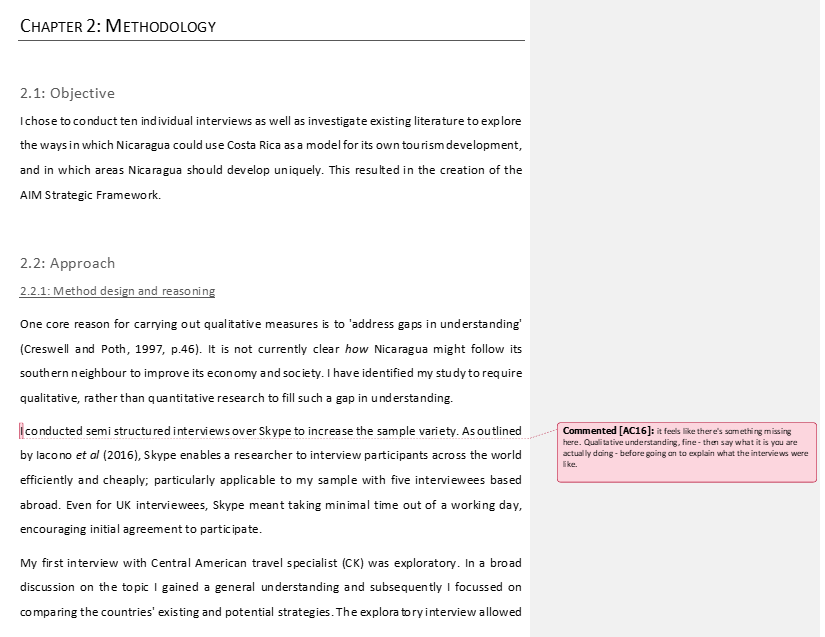
Results
The results chapter of your dissertation structure is typically around 20% of your word count. It presents the findings of your research in a clear and factual manner, without interpretation or commentary. Its purpose is to show exactly what the data revealed in relation to your research questions or objectives.
This chapter should be easy to navigate, logically structured, and concise. The emphasis should be on reporting – not explaining – the outcomes of your methods.
Presenting results clearly
Use a combination of narrative, tables, and visuals to make your results easy to understand:
- Text: Use concise paragraphs to introduce, summarise, and contextualise each set of findings. Avoid long lists of numbers or data points. Instead, guide the reader through the main outcomes and refer them to supporting visuals where appropriate.
- Tables: Useful for showing precise values, comparisons, and categories. Each table should be numbered and titled (e.g. Table 2: Questionnaire responses by age group), and introduced in the text before it appears. Only include relevant information – overly complex or unprocessed tables should be moved to the appendices.
- Graphs and charts: Bar charts, line graphs, scatterplots, and pie charts are effective for showing patterns, trends, and distributions. Visuals must be properly labelled (including axes, units, and figure numbers), and should add clarity rather than repeat information already stated in the text.
Aim for clarity, not quantity. Avoid including every detail from your dataset – focus on findings that are directly relevant to your research aims.
Quantitative and qualitative Results
There is no need to rigidly separate quantitative and qualitative results in your dissertation structure, but you should be aware of the differing conventions in how each type is presented.
Quantitative data is typically presented using:
- Descriptive statistics (means, medians, standard deviations, ranges).
- Inferential statistics (e.g. t-tests, ANOVA, chi-squared tests), along with significance values (e.g. p < .05).
- Structured visualisation: charts or tables to summarise numeric data at scale.
Results should be organised according to research questions, hypotheses, or variables tested. Be sure to state statistical values correctly and consistently, and report both significant and non-significant findings.
Qualitative data is usually presented by:
- Grouping findings into themes or categories identified during analysis (e.g. thematic or content analysis).
- Including concise quotes from participants to illustrate each theme.
- Summarising patterns or variations observed in the data.
Avoid excessive quoting or anecdotal reporting. Use subheadings and summarised text to structure the results, with quotations used sparingly to support each theme.
In mixed-methods research, integrate the presentation of results where it makes sense, but keep the distinction between data types clear.
Avoiding data misrepresentation
Maintaining the integrity of your results is critical. Common pitfalls to avoid include:
- Cherry-picking findings: Report all relevant outcomes, including those that were unexpected or not statistically significant.
- Misleading visuals: Do not alter axes, scale, or data selection in a way that exaggerates or distorts the findings.
- Overstating findings: Avoid language that implies causality or significance beyond what your data shows.
- Duplicating content: Don’t repeat the same information across text, tables, and graphs without adding value.
All findings should be reported honestly, accurately, and transparently. If your data has limitations (e.g. small sample size or incomplete responses), these can be addressed later in the discussion.
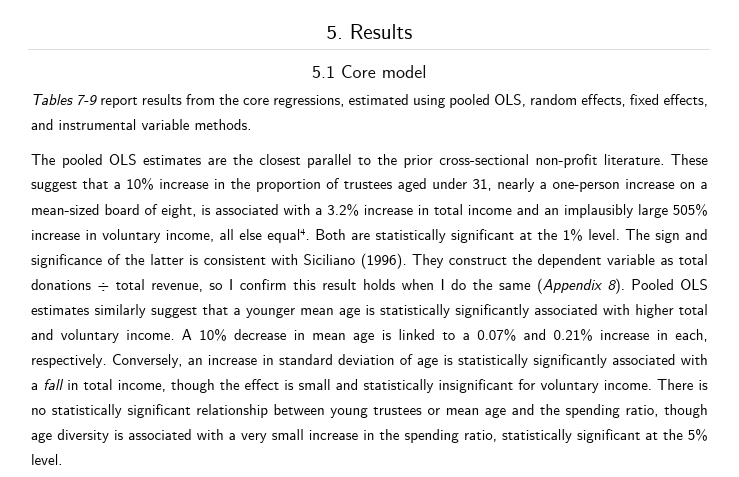
The video below is a webinar from the University of Southampton which is helpful to review before writing your Results section.
Discussion
The Discussion chapter of your dissertation structure is typically around 20% of your word count. This is where you delve into the meaning and importance of your research findings – it’s about explaining what your results mean and why they matter. Unlike the results chapter (which simply reports the data), the discussion interprets those results and builds an argument in relation to your research question and the existing literature. In practical terms, this section allows you to answer your research questions, explore the implications of your findings, and demonstrate how they connect to the broader context established in your literature review. It’s also the place to critically evaluate your study, by acknowledging limitations and suggesting what future research could be done. Below are key elements to include for a strong discussion chapter:
Recap and orient the reader:
Begin by briefly reminding the reader of the research problem or main question and the key findings from your results chapter. This provides context for the discussion that follows. For example, you might restate your central question and summarise the overall outcome in a few sentences. Starting with a clear recap ensures the reader remembers what you found, before you launch into why you found it and what it means.
Interpret and explain the findings:
After the brief recap, dig into your results and interpret them. Explain why you got the results you did and what they mean, especially in relation to your research questions or hypotheses. For each major finding, discuss whether it met your expectations and how it answers (or relates to) the questions you posed. It often helps to organise this part of the discussion thematically or by sub-question – for example, address each research question one by one, or group findings into key themes, just as you may have structured your results chapter. This logical structure will make it clear how each result contributes to answering your overall research problem.
As you provide interpretations, spell out the significance of the results: don’t assume the importance is obvious to the reader. Connect the dots and argue why these results matter. For instance, if a result is unexpected, discuss potential reasons and why it’s noteworthy. Keep the focus on analysis, not description – you’re now telling the reader what the results mean, not just what they are.
Connect to the literature and context:
A crucial part of the discussion is showing how your findings fit into the existing body of research. Relate each of your key findings back to the studies, theories, and frameworks you covered in your literature review. Do your results support, extend, or challenge previous studies? For example, “Our finding X is consistent with Smith’s (2018) theory, further confirming that…,” or “Contrary to Jones (2020), we found Y, suggesting that…”. By comparing your results with others, you demonstrate where your work stands in the scholarly conversation. If some of your results contrast with previous research, discuss possible reasons why. It’s often in these differences that you can find interesting insights. Don’t shy away from unexpected outcomes – acknowledge them and explore their implications. For instance, an unexpected result might be due to a different context or methodology, and discussing this can show your ability to think critically. The key is to contextualise your findings: show the reader how your research confirms or challenges what was already known, and highlight any new contribution of knowledge. This will underline the relevance of your research and give the discussion a strong scholarly foundation.
Discuss limitations of your study:
No study is perfect, and the discussion is an appropriate place to acknowledge the limitations of your research. Identify any weaknesses in your methodology, data, or scope that might affect how the results can be interpreted. For example, perhaps the sample size was small or not fully representative, or maybe there were constraints in data collection or analysis techniques. A common mistake is to either ignore limitations or to exaggerate them – instead, provide a balanced evaluation. Be honest about issues, but also put them into perspective. Recognising limitations actually strengthens the credibility of your research, as it shows you have critically assessed your work’s weaknesses. The goal is to give an accurate picture of what can (and cannot) be concluded from your findings. Importantly, don’t undermine your study’s value: after noting each limitation, you can remind the reader why the results are still meaningful in light of it. For instance, “Although the sample size is limited, this study provides initial evidence that…”. By candidly discussing limitations, you demonstrate academic integrity and help others understand the boundaries of your conclusions.
Suggest areas for future research:
Based on your findings and the limitations you’ve identified, it’s standard to propose future research directions. What next steps do you or other researchers need to take? Perhaps there are new questions that arose from your results, or aspects of your research problem that remain unexplored. You might suggest examining a different population, using a new method, or investigating a related variable. These suggestions show that you recognise the ongoing nature of research and how your work could be built upon. When making recommendations, be specific. Avoid generic statements like “More research is needed.” Instead, outline exactly what further research could address. For example: “Further studies could test whether this pattern holds in older adults,” or “Future experiments using higher resolution data could determine X,”. By grounding your recommendations in the limitations or interesting findings of your study, you provide a clear rationale for them. This forward-looking element demonstrates that you understand how your research fits into a bigger picture and what the next logical steps are for the field.
Combined results & discussion:
In some disciplines, you may not have a separate results and discussion chapter – instead, the two are combined into one integrated section. This approach is more common in certain humanities and qualitative studies. In a combined results/discussion structure, you would present and discuss the data together, often weaving analysis directly after each result rather than separating the chapters. For example, with qualitative interview data, a combined chapter might introduce a theme, give a quote or result, and then immediately discuss its meaning before moving to the next theme. In contrast, in many quantitative or experimental studies the convention is to keep results and discussion separate (first lay out all the results, then analyse them). If your discipline allows a combined chapter, the content we described above still needs to be covered, but the structure will be different. You might organise the chapter by themes or research questions, and for each one, present the relevant results followed by the interpretation and connection to literature in one seamless narrative. Always check your departmental guidelines or consult your supervisor to determine which structure is expected for your field. Whether separated or combined, the ultimate aim is the same: to present your findings clearly and then discuss what they mean in context.
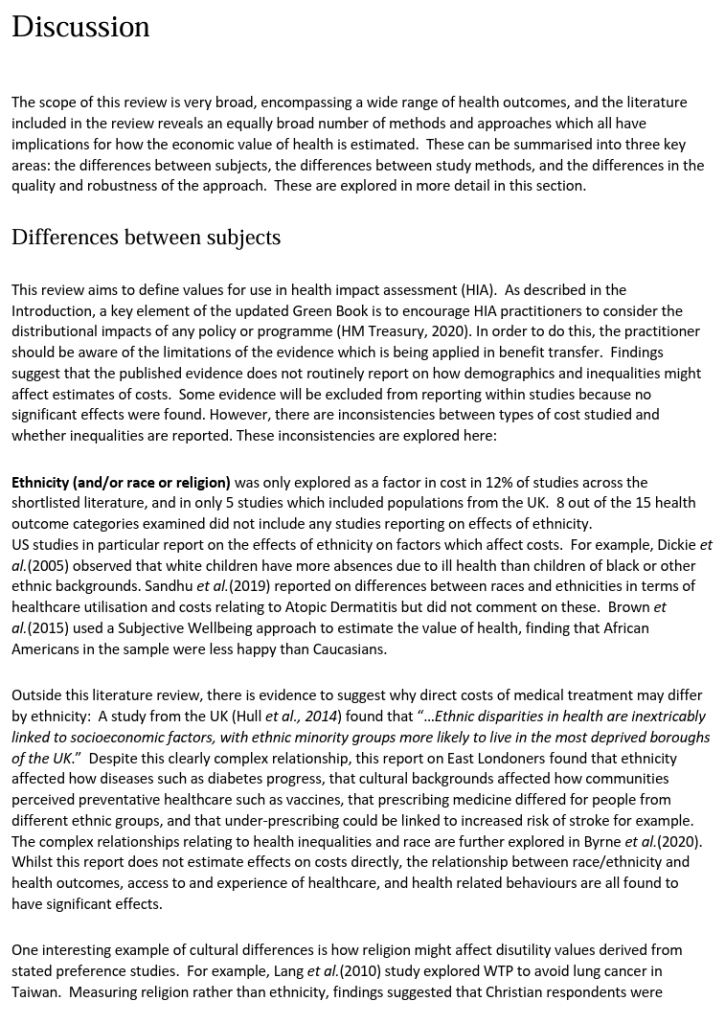
Conclusion
The Conclusion chapter of your dissertation structure is typically around 7% of your word count. It is the final chapter of your dissertation – its job is to wrap up your research with a clear, concise summary and reflection. In essence, the conclusion should answer your main research question one more time, drawing together the key insights from the entire work. This chapter matters because it’s the last thing the reader will read: it should leave them with a strong understanding of your study’s outcome and its significance. A good conclusion gives the feeling that the research journey has reached its end-point, and it reinforces what has been learned. Importantly, it does not present any new data or arguments. Think of it as closing the loop: you’re revisiting the initial problem or question set out in your introduction, and now you’re able to state the resolution clearly, having walked the reader through your research in the preceding chapters.
In writing the conclusion, keep it focused and factual. It will typically be relatively short and to the point. Here are the main things to include:
Summarise the overall findings:
Begin by summarising the key findings or arguments of your research. This is essentially a recap of what your study found, synthesised at a high level. A useful approach is to remind the reader of the overall aim or thesis of the dissertation (in other words, restate the research problem or objective) and then concisely state the outcome. For example, you might rephrase your research question as a statement and say it has been answered, highlighting the main evidence for it. This gives the reader a clear reminder of what you set out to do and what you discovered. The conclusion is a summary, not a repetition of earlier chapters, so don’t go into detail – just hit the main points. By the end of this part, the reader should have no doubt about what your most important findings were. (It’s often effective to write this summary in a way that directly mirrors the phrasing of your objectives or questions, to show clearly how each was met.)
Answer the research question directly:
Make sure that your conclusion explicitly answers your main research question (or fulfills your research objectives). Throughout the dissertation, you have likely hinted at this, but the conclusion is the place to state it plainly and definitively. For instance, if your dissertation asked “To what extent does X affect Y?”, your conclusion should clearly state “The research finds that X affects Y to a great extent (with these qualifications)…”. By doing this, you’re drawing a direct line from the question posed at the start to the answer provided by your research. This might seem obvious, but it’s crucial: a dissertation can contain a lot of complex information, so the reader will appreciate a clear statement of the answer. If you had multiple research questions or hypotheses, you should address each of them in turn, summarising the conclusion you reached for each one. Essentially, the reader should finish this section with a clear understanding of your overall argument or solution to the problem you set out to investigate.
Highlight the significance of the study:
A strong conclusion not only states what was found but also why it matters. Take a moment to impress upon the reader the implications of your findings. This could mean discussing the contributions your research has made to the field – for example, have you filled a gap in the literature, provided new evidence or confirmed a theory? You might also mention any practical implications if relevant (e.g. how findings could be applied in policy, education, industry, etc.). Essentially, explain what new insight or value your work has added to the understanding of the topic. This doesn’t mean introducing new arguments, but rather drawing together threads that were already discussed (perhaps in your discussion chapter’s implications section) to give a final statement of the importance of your results. For example: “This study’s results strengthen the evidence for X, which could inform how we approach Y in future.” By emphasising the significance, you ensure the reader is left appreciating the contribution of your research, not just the fact that you did it. It answers the “So what?” question – why should anyone care about these findings? A good conclusion convinces the reader that the project was worthwhile and has made a useful contribution to knowledge.
No new information:
Absolutely no new data, findings, or arguments should appear in the conclusion. Everything here should have been mentioned somewhere earlier in the dissertation. You are closing the discussion, not adding to it. Introducing new information at this stage would only confuse the reader and undermine the sense of resolution. Similarly, avoid raising brand new questions or issues in the conclusion. It’s fine to suggest ideas in the context of future research or implications (as noted above), but these should be clearly framed as suggestions based on your existing discussion. The bottom line is to stick to what has been covered.
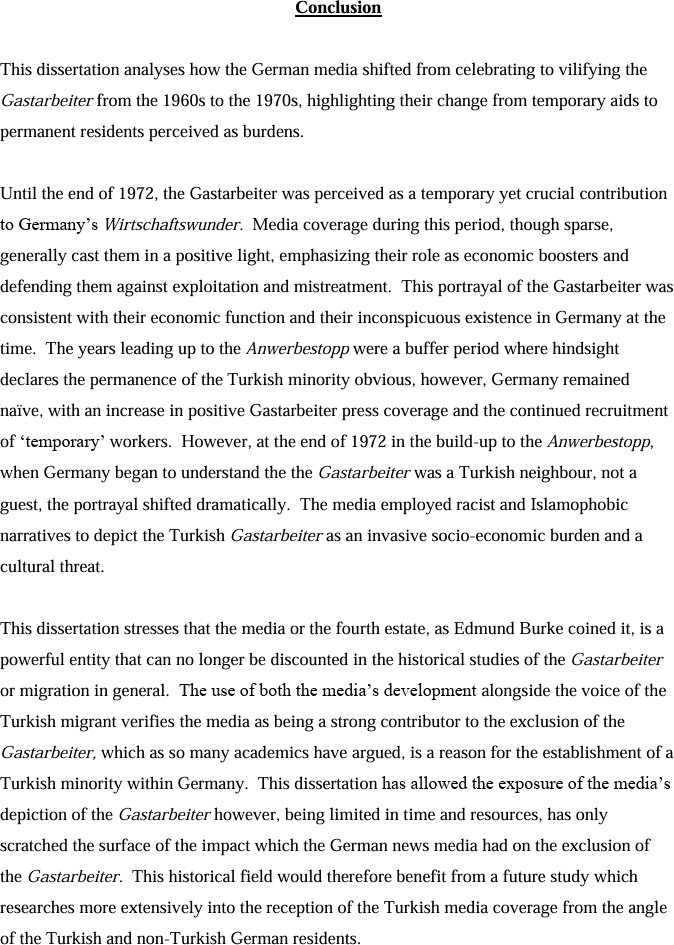
References and bibliography
At the end of your dissertation, you must include a complete list of all the sources you’ve cited. This is essential for academic integrity, allowing readers to trace your evidence and protecting you against plagiarism.
What’s the difference between a References list and a Bibliography?
- A References list includes only the sources you have directly cited in your dissertation. This is the standard and expected format in most UK universities.
- A Bibliography includes everything you read, whether or not you cited it in the text. This may be requested in some humanities subjects, or if you’ve done significant background reading that supports your understanding.
Unless your department specifies otherwise, always assume that a References list is required, and follow the appropriate formatting style throughout.
Common referencing styles
Different academic disciplines use different citation systems. Some of the most common in UK universities include:
- Harvard (Author-Date): Widely used across subjects. In-text citations include the author’s surname and year (e.g. Smith, 2021).
- APA (American Psychological Association): Common in psychology and social sciences. Similar to Harvard but with strict formatting rules.
- MLA (Modern Language Association): Used in humanities. In-text citations refer to author and page number, with full details in a “Works Cited” section.
- OSCOLA (Oxford Standard for the Citation of Legal Authorities): Used in law. Footnote-based, with no in-text citations.
Check your course handbook or ask your supervisor to confirm which style you’re expected to use.
Citation tools & software recommendations
To manage your references efficiently and ensure correct formatting, consider using a referencing tool. These can save hours of manual editing:
- UKEssays.com: Simple up-to-date browser-based tool supporting Harvard, APA, and Vancouver. Useful for quick fuss-free citations and no registration necessary to use.
- Zotero: A powerful, free tool for managing references and generating in-text citations. Integrates with Word and Google Docs.
- Mendeley: Excellent for research-heavy projects. Organise sources, annotate PDFs, and cite as you write.
- EndNote: Advanced tool often used by postgraduates and researchers. Offers strong academic database integration.
- Citationsy: A clean and flexible tool with support for over 9,000 styles. Good for building bibliographies and syncing across devices.
While these tools are helpful, always proofread your reference list to ensure it matches your university’s formatting rules exactly.
